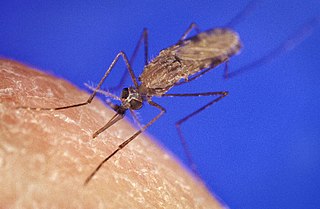
The Culicomorpha are an infraorder of Nematocera, including mosquitoes, black flies, and several extant and extinct families of insects. They originated 176 million years ago, in the Triassic period. There are phylogenetic patterns that are used to interpret bionomic features such as differences in the nature of blood-feeding by adult females, daytime or nighttime feeding by adult females, and occurrence of immature stages in aquatic habitats.

A midge is any small fly, including species in several families of non-mosquito Nematoceran Diptera. Midges are found on practically every land area outside permanently arid deserts and the frigid zones. Some midges, such as many Phlebotominae and Simuliidae, are vectors of various diseases. Many others play useful roles as prey for insectivores, such as various frogs and swallows. Others are important as detritivores, and form part of various nutrient cycles. The habits of midges vary greatly from species to species, though within any particular family, midges commonly have similar ecological roles.

Leptoconops torrens is a species of small biting flies in the no-see-um family Ceratopogonidae. They were first mentioned in writing by Charles Henry Tyler Townsend in 1893. The name Leptoconops carteri is a junior synonym of L. torrens. They are prevalent in the southwestern and southeastern areas of the United States. In early stages of life, L. torrens flies dwell in soil, then emerge to feed and breed as fully developed adults.

The Nematocera are a suborder of elongated flies with thin, segmented antennae and mostly aquatic larvae. This group is paraphyletic and contains all flies but species from suborder Brachycera, which includes more commonly known species such as the housefly or the common fruit fly. Families in Nematocera include mosquitoes, crane flies, gnats, black flies, and multiple families commonly known as midges. The Nematocera typically have fairly long, fine, finely-jointed antennae. In many species, such as most mosquitoes, the female antennae are more or less threadlike, but the males have spectacularly plumose antennae.

Ceratopogonidae is a family of flies commonly known as no-see-ums, or biting midges, generally 1–3 millimetres in length. The family includes more than 5,000 species, distributed worldwide, apart from the Antarctic and the Arctic.

The Chironomidae comprise a family of nematoceran flies with a global distribution. They are closely related to the Ceratopogonidae, Simuliidae, and Thaumaleidae. Many species superficially resemble mosquitoes, but they lack the wing scales and elongated mouthparts of the Culicidae.

The Chironomoidea are a superfamily within the order Diptera, suborder Nematocera, infraorder Culicomorpha. This superfamily contains the families Chironomidae, Ceratopogonidae, Simuliidae, and Thaumaleidae.

Belgica antarctica, the Antarctic midge, is a species of flightless midge, endemic to the continent of Antarctica. At 2–6 mm (0.08–0.2 in) long, it is the largest purely terrestrial animal native to the continent. It also has the smallest known insect genome as of 2014, with only 99 million base pairs of nucleotides and about 13500 genes. It is the only insect that can survive year-round in Antarctica.

Culex pipiens, commonly referred to as the common house mosquito, is a species of mosquito. House mosquitoes are some of the most common mosquitoes. More specifically, Culex pipiens is considered as the northern house mosquito, as it is the most common mosquito to the northern regions of the US. North of the 39th parallel north in the US, only C. pipiens are present, whereas south of the 36th parallel north, only C. quinquefasciatus are present. Additionally, they can be found in both urban and suburban temperate and tropical regions across the world.

Chironomus plumosus, also known as the buzzer midge, is a species of nonbiting midge (Chironomidae) that occurs throughout areas in the Northern Hemisphere.

Chironomus is a genus of nonbiting midges in the subfamily Chironominae of the bloodworm family, Chironomidae, containing several cryptic species that can only be distinguished by experts based on the characteristics of their giant chromosomes.
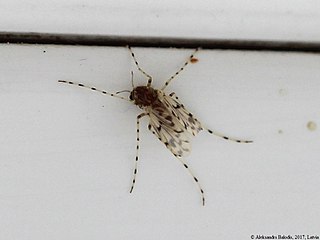
Tanypodinae is a subfamily of midges in the non-biting midge family (Chironomidae). The larvae are generally carnivorous and their mouthparts are adapted for predation on small invertebrates although 1st and 2nd instar larvae also feed on algae.
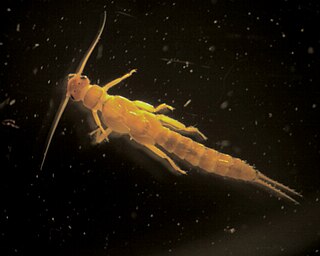
Chloroperlidae are a family of stoneflies, commonly known as green stoneflies, with more than 200 species and 22 genera. They appear green to yellow in colour, and are popularly used among fisherman as bait for trout fishing. Green stoneflies live in the benthic zone of the cold streams and rivers of five continents and four zoogeographical regions, emerging from the water to live in the riparian zone as adults. They are sensitive to pollutants, making them an indicator species for determining the quality of water bodies. Chloroperlidae are hemimetabolous, having no pupal stage, but instead hatch from eggs as nymphs and mature directly into adults. They are omnivorous, feeding on small organisms and plant particles, and become more carnivorous as they mature. The classification of Chloroperlidae is contested, with some believing that they should be considered as members of different orders, as opposed to the order Plecoptera that they currently belong to.

Coelopa frigida is a species of seaweed fly or kelp fly. It is the most widely distributed species of seaweed fly. It can be found on most shorelines in the temperate Northern Hemisphere. Other species of seaweed flies include Coelopa nebularum and Coelopa pilipes. C. frigida feeds primarily on seaweed, and groups of C. frigida flies tend to populate near bodies of water. Climate change has led to an increase in C. frigida blooms along shores, which creates a pest problem for human beach-goers. C. frigida is also an important organism for the study of sexual selection, particularly female choice, which is influenced by genetics.
Chironomus riparius, also known as Chironomus thummi and commonly known as the harlequin fly, is a species of non-biting midge. Their larvae are known by the common name of blood worm due to their red colouration. It is common in both North America and Europe. The species was described in 1804 by Johann Wilhelm Meigen. C. riparius has been used extensively as a model for genome structure analysis in insects and is also used in toxicology tests and functional developmental genetic studies. Both their adult and larval forms have been implicated as disease vectors but are also an important part of freshwater food chains.
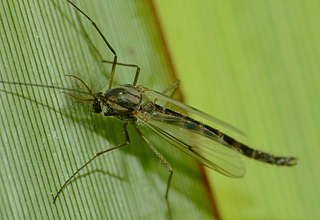
Chironomus zealandicus, commonly known as the New Zealand midge, common midge, or non-biting midge, is an insect of the Chironomidae family that is endemic to New Zealand. The worm-like larvae are known to fisherman and have a common name of blood worm due to their red color and elongated blood gills.

Anopheles freeborni, commonly known as the western malaria mosquito, is a species of mosquito in the family Culicidae. It is typically found in the western United States and Canada. Adults are brown to black, with yellow-brown hairs and gray-brown stripes on the thorax. Their scaly wings have four dark spots, which are less distinct in the male.
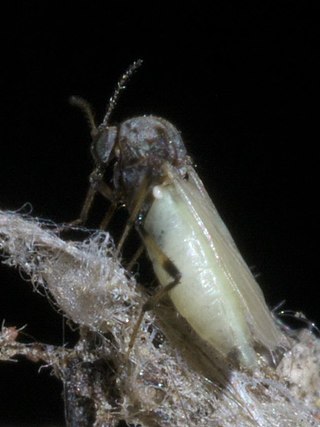
Bezzia nobilis is a species of biting midges in the family Ceratopogonidae. It is widely considered one of the most common Bezzia species; it is found in Eurasian regions, all over the United States, Central America, and even into South American countries like Brazil. B. nobilis seem to prefer aquatic environments; they are commonly observed in stagnant water pools in Eurasia regions and marshes in the southern United States. Adults of this species are easily distinguished by their black and yellow striped legs. Pupae are recognized by their brown bodies, abdominal spines, and respiratory horns. B. nobilis larvae are distinguished by brown heads and white bodies. Little information is known on their life cycle or mating habits. B. nobilis is a predatory species. While some research suggests they mainly feed on larvae of other insect species, experiments suggest they prefer immobile, easy prey such as dead adult flies, bacteria, and protozoa.

Aedes taeniorhynchus, or the black salt marsh mosquito, is a mosquito in the family Culicidae. It is a carrier for encephalitic viruses including Venezuelan equine encephalitis and can transmit Dirofilaria immitis. It resides in the Americas and is known to bite mammals, reptiles, and birds. Like other mosquitoes, Ae. taeniorhynchus adults survive on a combination diet of blood and sugar, with females generally requiring a blood meal before laying eggs.

Tokunagayusurika akamusi is a midge fly species of the family Chironomidae, commonly called "nonbiting midges" or "lake flies."






















